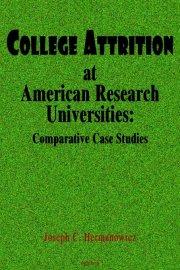
Sound Bite
Undergraduate attrition is an issue of growing concern in the field of higher education - it now even has its own scholarly journal. This work is the first book on college attrition to present case studies based on specific institutions of higher learning, examining in detail the practical concerns that cause students to drop out and what can be done to cut the drop-out rate. The book adds an important voice from the students themselves, whose views have often been omitted from the discussion.
About the Author
Joseph C. Hermanowicz is an Assistant Professor of Sociology at the University of Georgia. His previous works include the book, The Stars Are Not Enough: Scientists - Their Passions and Professions (U Chicago, 1998), and dozens of articles and conference papers, mostly focusing on student, parent and faculty satisfaction with the academic experience.
|
|
About the Book
College Attrition was written as a result of the author's scholarly interest in the question of Why students quit, combined with the concern expressed by the leaders of the four institutions in the study. While responding to and building on trends...
College Attrition was written as a result of the author's scholarly interest in the question of Why students quit, combined with the concern expressed by the leaders of the four institutions in the study. While responding to and building on trends in existing work in this field, the current work departs from existing literature both empirically and theoretically. The book studies university drop-out rates, looking at quantitative data but also, and primarily, relying on qualitative interviews with students who have left school. Students' accounts, most often the unseen side of the equation, reveal extraordinarily consequential insights into the attrition process itself and to what interventions can be effectively introduced to stem it.Theoretically, the work is set in a context that is enlarged by examining attrition within the organization - right in the schools in which it is found. Most previous research has treated attrition as an abstract process.While the data are based on and are primarily focused on research universities, the findings and many of the conclusions are germane to a host of other institutional types.
|
Everyone who has come into contact with American higher education, whether their relationship has been brief and fleeting or long-lived and intimate, has been exposed to one of the few phenomena shared by the more than 3500 motley schools in the system: college attrition. Parents of students, friends, relatives, high school teachers and guidance...
Everyone who has come into contact with American higher education, whether their relationship has been brief and fleeting or long-lived and intimate, has been exposed to one of the few phenomena shared by the more than 3500 motley schools in the system: college attrition. Parents of students, friends, relatives, high school teachers and guidance counselors, college administrators, university faculty and advisors all know that many students do not complete their programs, for various reasons. They know attrition not necessarily through cold-blooded statistics but more probably through the stories of warm-blooded students who have experienced college departure, those whose vantage points are undoubtedly the most direct and personal.There is indeed irony in the thought that the failure to educate is the single principal attribute binding schools together in the highly differentiated system we call higher education. While schools do educate, and do so in relatively large numbers, and thus produce and transmit knowledge as their function prescribes, they do so in proudly different ways that yield different outcomes and identities, both collective and individual. Yet when colleges and universities lose students, they fail; and their outcome and identity are one. Why do some students quit? What can be done to help students make it to graduation? Are we doing enough to reduce the drop-out rate?
|
INTRODUCTION Research UniversitiesInteraction and School Organization: A Contextual View1. DESIGN AND METHODS The Schools The Data 2. THE SOCIAL CONTEXT OF ATTRITION Gender, Race, and Ethnic Profile A
INTRODUCTION Research UniversitiesInteraction and School Organization: A Contextual View1. DESIGN AND METHODS The Schools The Data 2. THE SOCIAL CONTEXT OF ATTRITION Gender, Race, and Ethnic Profile Academic Profile Financial Profile Summary 3. THE PROCESS OF ATTRITION Departure Timing Departure Reasons The Character of the Departure Process Interaction Students' Re-assessments Summary 4. STRUCTURE AND CULTURE OF RETENTION A Retention Success Story: Case in View Cultural Attributes of Schools and Success Summary 5. LEAVING RESEARCH UNIVERSITIES Summary and Discussion Generalizability Lessons from a Contextual View APPENDIX Interview Protocol REFERENCES
|
Why do college student departure rates vary ? | More »
Why do college student departure rates vary ?
Hermanowicz asks an important question: Why do college student departure rates vary among elite institutions of higher learning in the United States? This book breaks new ground as this question has not been previously explored in an empirical way. An empirical treatment of this question is important both theoretically and practically. This volume makes a substantial contribution to the voluminous body of literature on college student departure.
John M. Braxton Professor of Education, Department of Leadership, Policy and Organizations, Peabody College, Vanderbilt University
|
|
Pages 120
Year: 2002
LC Classification: LC148.2.H47
Dewey code: 378.1'619
BISAC: EDU015000
Paper
ISBN: 978-0-87586-189-0
Price: USD 21.95
Hard Cover
ISBN: 978-0-87586-190-6
Price: USD 29.95
Ebook
ISBN: 978-0-87586-188-3
Price: USD 29.95
|













